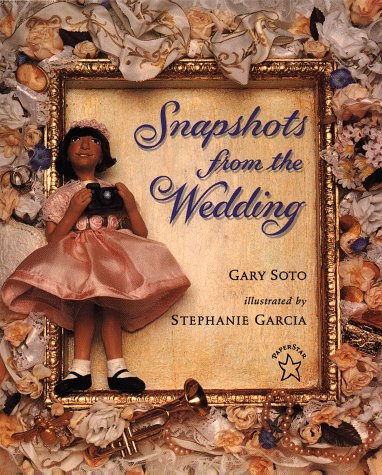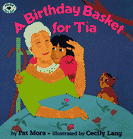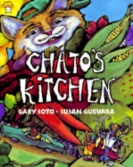

Hispanic Literature

Soto, Gary. Snapshots from the wedding. New
York: G. P. Putnam’s Sons, 1997.
ISBN 0-399-22808-X.
Maya is a flower girl in her cousin, Isabel’s wedding. Maya recounts specific moments from the day in the form of “snapshots.” First, she introduces the reader to her cousin, Danny, the bride, Isabel, Rafael, the groom, and then the bride’s parents. Each of the characters is experiencing something that all of us, at one time or another, have either seen or experienced at a wedding: the silly cousin wiggling his tongue throughout the ceremony, the yawning altar boy, the uncle in the itchy suit, and the beautiful bride with sparkling eyes. Maya takes the reader from the beginning of the wedding ceremony straight through the traditional wedding dance/celebration, where she winds up falling asleep. She ends her tale with the mention of the mole on her dress, which will remind her again the next day of the wonderful time she had at the wedding.
This story is a wonderful presentation of the Mexican wedding experience. Soto includes the many rich traditions of such an event, from the mole to the dollar dance. A glossary is included at the beginning of the book for monolingual English readers, although the Spanish vocabulary blends so expertly within the text, one might not need to use the glossary at all. Spanish words are interlaced within the English text with no literal translations present. This makes for a pleasurable reading experience for bilingual readers as the story flows without any redundant Spanish/English translations.
The artwork, by Stephanie Garcia, is 3-D, and created using clay, paint, fabric, wood, and other objects, including actual rice. The “snapshots” really drive home the experience of the Mexican wedding! The inclusion of the traditional pearlized wax beads in the bouquets is a subtle, yet powerful touch, as is the image of the tiny twenty dollar bills pinned to the bride’s gown. One particularly fun “snapshot” is of the children’s socked feet! They had been running down the hallways in their socks while the grown-ups were occupied dancing. The image of their dirty little socks helps reinforce the fact that this story is presented from a young child’s point of view.
The authenticity of this story shines through in Soto’s text and Garcia’s illustrations!
 Mora,
Pat. Birthday
basket for tia. New York:
Aladdin, 1992. ISBN 0-02-767400-2.
Mora,
Pat. Birthday
basket for tia. New York:
Aladdin, 1992. ISBN 0-02-767400-2.
Young Cecilia searches for an appropriate birthday present for her great-aunt’s 90th birthday. Her elderly aunt holds a very special place in Cecilia’s heart. She gathers items from around her house that remind her of the many good times she and her tia have shared. She first gathers a book that her tia often reads to her. She then gathers a mixing bowl that they use when they make traditional Mexican sugar cookies. As Cecilia goes around her house, she finds more things that spark particular memories, and she adds the items into the special basket that she is going to give her tia as a birthday gift. Finally, at the surprise party, Cecilia presents the basket to her great aunt, who surprises everyone by dropping her cane and dancing with her niece.
This story is filled with traditional cultural markers. A Birthday Basket for Tia depicts many ideas that are important in the Mexican culture. First, the idea of a close-knit, extended family is presented. Although the aunt apparently does not live in the same household as Cecilia, she is a frequent visitor who takes part in many of the family’s daily activities, such as cooking and reading. Another culturally important facet is the presence of cooking or food. The young girl describes the smell of beans bubbling on the stove, a smell that is very familiar to anyone who has grown up in a traditional Mexican-American household. One event in the story presents a stereotypical view of Mexican-American activity: Cecilia and her mother work together to fill a piñata for the aunt’s surprise party. In the Southwest, piñatas are often used at children’s parties, but usually are not part of party festivities for adults. On another note, one might notice that there are no men in the household until it is time for the party. Is this an indication of gender specific duties within the culture? Did the author present the story’s females in the kitchen-duty role and omit the male’s presence there intentionally?
A Birthday Basket for Tia is very obviously written for monolingual English readers. Particular Spanish words and phrases are used within the text, but are accompanied by literal translations, such as “I draw a picture of my aunt, my Tia,” or, “Tia and I like to make bizcochos, sugary cookies for the family.” Spanish speaking readers may find the translations redundant.
The artwork, by Cecily Lang, presents a beautiful picture of this family’s surroundings. Lang uses torn paper art to create the illustrations. Each picture is bold and bright, and creates a festive party environment. The faces of the party guests are done in various shades of tan, giving the reader a true sense of the variety of skin tones shared by all who attended the party.
 Ancona,
George. Fiesta U.S.A. New York:
Lodestar Books, 1995. ISBN 0-525-67498-5.
Ancona,
George. Fiesta U.S.A. New York:
Lodestar Books, 1995. ISBN 0-525-67498-5.
Fiesta U.S.A. begins with a discussion about why immigrants hold particular celebrations, in this case, Spanish-speaking immigrants and fiestas. Ancona tells of the importance of fiestas as a way to preserve traditions from the old country and as a way to bring community members together. The book presents four fiestas that Hispanic people celebrate in the United States: Day of the Dead (El Dia de los Muertos), Christmas and the tradition of Las Posadas, New Year’s Day, and Three Kings’ Day.
In each section, Ancona describes the history or origin of each celebration and then presents a picture of how the holiday is celebrated today in different parts of the United States, from San Francisco to New Mexico to the barrio in New York City.
Ancona’s colorful photographs provide the reader with an up-close view of the celebrations. The costumes, foods, and activities are shown right next to explanatory text, which helps the reader understand how these unique celebrations take place. Although literal translations of Spanish terms are included within the text, a glossary is placed at the end of the book. The fact that the photographs show modern people participating in sometimes ancient celebrations is helpful for children who often do not connect the idea that these celebrations are being practiced even today. Many times, when children are not directly involved in such situations, they believe that these things happened only in the “old days.”
This is a beautiful depiction of some very important celebrations that have been brought into the United States. All children can benefit from reading this book!
 Soto,
Gary. Chato’s kitchen. New York: Putnam
& Grosset, 1995. ISBN 0-698-11600-3.
Soto,
Gary. Chato’s kitchen. New York: Putnam
& Grosset, 1995. ISBN 0-698-11600-3.
Chato is a cool, low-riding cat who becomes excited when he spots a family of five mice moving into the house next door. He decides they will become his dinner and he thinks up a plan to get them to come over to his place. Chato sends a paper airplane dinner invitation over the fence to the mice’s house. The mice are leery, but then they realize their old friend, Chorizo, is coming over for a visit. (Chorizo just happens to be a low-riding weiner dog, who can protect the mice from the ploys of old Chato!) In the meantime, Chato and his best friend, Novio Boy, cook up some traditional food for their upcoming feast. Soon, it is time for the dinner party & Mami mouse announces their arrival at Chato’s by saying they brought Chorizo. Chato & Novio Boy are so excited, thinking they’ve not only outsmarted the mice, but that they are going to have some sausage to boot! The two cats were scared out of their wits when they saw their uninvited guest. After the dust settles, they all settled down to a great feast, although it is not what the cats had in mind!
Gary Soto sets this story in East Los Angeles, a predominantly Mexican-American community. The characters in the book are not unlike people one might see in “East Los.” The main character, Chato, is a street-smart cat, whose best friend, Novio Boy, dresses the part of the East L.A. homeboy, with the red bandana around his forehead and only the top button of his plaid shirt buttoned. The mouse family consists of the mother (Mami) mouse, the father, the teenage daughter, and two younger boys. Soto includes many Spanish terms within the story’s text. Most terms are contextually translated, although some are not. A glossary is included at the beginning of the book.
Susan Guevara’s illustrations are key to this book. The bold drawings depict the scene in the barrio. She includes items one might associate with traditional Mexican-American families, such as the presence of religion in the household, as seen in the Last Supper wall-hanging in Chato’s dining room or the altar in his living room. The expressions on the characters’ faces make the story believable, for instance, when the two cats saw Chorizo for the first time. Added details, like the little “lives” or “souls” escaping from Chato and Novio Boy’s bodies when they eye Chorizo, make for a fun, although dark, experience! The contrasts within the illustrations make the images pop right into the reader’s head.
This is a fun story. Readers of all ages and backgrounds will appreciate the story and the illustrations.